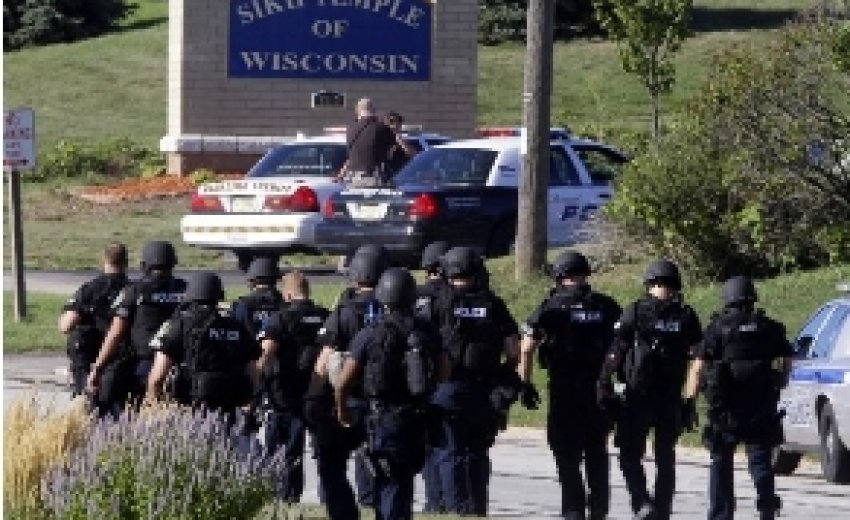
Oak Creek : Aug. 28, 2012 - Investigators haven't been able to interview the police officer who was seriously wounded in the Aug. 5 attack on the Sikh Temple of Wisconsin, Oak Creek Police Chief John Edwards said Tuesday.
Edwards said Lt. Brian Murphy "has some damage to his throat. They want his throat to heal up."
"He's able to whisper a bit," Edwards said. "Otherwise he has got an electronic device we have provided him. He's able to type."
Edwards added, "He still has a long road ahead of him. He has a ways to go. It's going to take a long time to heal, and he's probably going to have permanent injuries. But from where he started, I truly believe he's here for a reason."
Murphy, who was shot eight or nine times in the attack, was released Aug. 22 from Froedtert Hospital in Wauwatosa. In addition, Murphy's body armor stopped three other rounds, Edwards said.
Wade Michael Page, 40, killed six people and wounded four others in the attack before he was shot by an Oak Creek police officer. Page then committed suicide.
During a Milwaukee Press Club luncheon Tuesday at the Oak Creek Community Center, Edwards, Oak Creek Mayor Steve Scaffidi and Oak Creek Fire Chief Tom Rosandich discussed the shooting and how they made sense of a chaotic, fast-breaking situation.
"Obviously you never want an event like this (to be) something you're known for," Scaffidi said. "We're going to take this tragic event and make it something positive."
Edwards said police alone cannot stop such heinous acts of violence.
"We need you to be aware and look out for things and not just count on us," he said.
Edwards said the gunman was motivated by hate.
"There was no specific group he was after, or disliked more than the other," Edwards said. "He could have gone past a Korean church, a black Baptist church, could have gone past a Muslim church. Anyone different, it's a personal hate. He just hated."
Rosandich said he is grappling with how those in his department deal with the long-term effects of the attack. He mentioned two firefighters, only four months on the job, who worked the day of the attack.
"You drive past the Sikh Temple on a daily basis, you're going to turn your head, 'Yeah, this happened,' " Rosandich said. "We can't forget the history that happened, but we have to remember our people are dealing with this on a long-term basis."
The men in charge found out about the attack in different ways.
The mayor, Scaffidi, was alerted by a tweet.
The fire chief, Rosandich, received a call at home as he was preparing to go to his mother-in-law's house.
The police chief, Edwards, who was helping his daughter move, saw Milwaukee County sheriff's deputies setting up a roadblock, knew something was amiss and contacted a dispatcher.
"There are playbooks out there for this kind of stuff," Edwards said, but the situation was unlike any the city had ever seen.
Edwards said he listened to audiotapes of emergency calls made during the attack, with some of the calls made from worshippers inside the temple.
"It was apparent one of the issues we had was a language barrier," he said.
It also was difficult to provide real-time information for officers on the scene because things were happening so quickly and there were many reports of gunfire. Some 911 calls were routed from the Milwaukee County Sheriff's Office to Oak Creek police.
There also was uncertainty over whether more than one gunman was present.
"There were multiple calls coming in from different locations, plus international calls from relatives," Edwards said.
Edwards said he made the decision to have the FBI investigate the mass shooting, while the Milwaukee Police Department homicide unit handled the death of the gunman.
"Because of the gravity, all of our resources were taxed," he said.
With scores of law enforcement personnel on the scene, plus six armored vehicles, nine K-9 units as well as helicopters overhead, Edwards said, "I was looking for familiar faces."
"As far as the initial response, it was very chaotic, impossible to describe what was going on in that little microcosm of a small city in that parking lot" at the temple, Edwards said.
He also explained to several members of the Sikh community why it took hours to notify next-of-kin that their loved ones were killed.
"We still had an active scene," Edwards said.
Edwards also said help was provided by a member of the temple, who was also an FBI agent. The agent tried to identify as many victims as he could without moving the bodies, Edwards said. He also provided police a layout of the temple.
Bathair Singh Dulai, the temple treasurer, said he will relay the information to other members of the community.
"We have to remember if an officer is injured on the job, he can't do his job," Dulai said.

